CHAPTER 5
GED® Social Studies Test 1
This practice test is modeled on the format, content, and timing of the official GED® Social Studies test and, like the official exam, presents a series of questions that focus on the fundamentals of social studies reasoning.
Part I
You’ll be asked to answer questions based on brief texts, maps, graphics, and tables. Refer to the information provided as often as necessary when answering the questions.
Work carefully, but do not spend too much time on any one question. Be sure to answer every question.
Set a timer for 65 minutes (1 hour and 5 minutes), and try to take this test uninterrupted, under quiet conditions.
Part II
The official GED® Social Studies test also includes an Extended Response question—an essay question. Set a timer for 25 minutes and try to read the given passage, brainstorm, write, and proofread your essay uninterrupted, under quiet conditions.
Complete answer explanations for every test question and sample essays at different scoring levels follow the exam. Good luck!
PART I
35 total questions
65 minutes to complete
Please use the following passage to answer questions 1–3.
This excerpt is from a speech by George W. Bush given on March 19, 2008.
Operation Iraqi Freedom was a remarkable display of military effectiveness. Forces from the U.K., Australia, Poland, and other allies joined our troops in the initial operations. As they advanced, our troops fought their way through sandstorms so intense that they blackened the daytime sky. Our troops engaged in pitched battles with Fedayeen Saddam, death squads acting on the orders of Saddam Hussein that obeyed neither the conventions of war nor the dictates of conscience. These death squads hid in schools, and they hid in hospitals, hoping to draw fire against Iraqi civilians. They used women and children as human shields. They stopped at nothing in their efforts to prevent us from prevailing, but they couldn’t stop the coalition advance.
Aided by the most effective and precise air campaign in history, coalition forces raced across 350 miles of enemy territory, destroying Republican Guard divisions, pushing through the Karbala Gap, capturing Saddam International Airport, and liberating Baghdad in less than one month.
Because we acted, Saddam Hussein no longer fills fields with the remains of innocent men, women, and children. . . . Because we acted, Saddam’s regime is no longer invading its neighbors or attacking them with chemical weapons and ballistic missiles.
1. Based on the primary-source excerpt concerning a central idea of American foreign policy since 9/11, what was President Bush’s purpose for launching Operation Iraqi Freedom?
a. to liberate Baghdad in less than one month by destroying Republican Guard divisions
b. to liberate Iraqi people from a brutal regime and remove Saddam Hussein from power
c. to stop Saddam Hussein from invading other nations
d. to join countries in aiding Saddam Hussein’s control of the Iraqi people’s natural rights
2. Which of the following statements is an opinion, NOT a fact?
a. “coalition forces raced across 350 miles of enemy territory, . . . liberating Baghdad in less than one month”
b. “Forces from the U.K., Australia, Poland, and other allies joined our troops in the initial operations.”
c. “Our troops engaged in pitched battles with Fedayeen Saddam, death squads acting on the orders of Saddam Hussein.”
d. “Operation Iraqi Freedom was a remarkable display of military effectiveness.”
3. Based on the primary-source excerpt, what can be concluded about the credibility of Bush’s choice to launch Operation Iraqi Freedom?
a. The operation was not justified and Bush makes this clear in his speech.
b. Bush feels that the operation was justified, but the realities of Saddam’s regime discredit any justification.
c. The operation was justified in trying to bring down a detrimental and brutal regime.
d. The actions of Saddam’s regime justify the operation, but Bush expresses his concern that the operation may not have been justified in his speech.
Please use the following to answer questions 4–6.
This excerpt is from the U.S. Constitution.
The President shall be Commander in Chief of the Army and Navy of the United States, and of the Militia of the several States, when called into the actual Service of the United States . . . He shall have Power, by and with the Advice and Consent of the Senate, to make Treaties, provided two thirds of the Senators present concur.
4. In this portion of the U.S. Constitution, which branch of the government checks the power of which other branch of government by a two-thirds agreement?
a. the executive checks the power of the legislative
b. the judicial checks the power of the executive
c. the legislative checks the power of the executive
d. the legislative checks the power of the judicial
5. Why is it important for the U.S. Constitution to include rules, such as the one in the excerpt, that allow for power checking between the different branches of government?
a. to ensure that the legislative branch has power over the executive and judicial branches
b. to ensure a separation of power that balances the powers of the three branches in order to prevent any one person or group from holding too much or all power
c. to ensure that the president has the ability to check the power of all other branches
d. to ensure that the president does not have the power to make treaties without some say from the Senate
6. Based on the excerpt from the U.S. Constitution, what can you infer would be the effect of a failure to receive a two-thirds agreement from the Senate in this instance?
a. the Senate could not make a treaty but the president could make a treaty
b. the Senate could make a treaty
c. the president could not make a treaty because the Senate does not agree
d. the president could make a treaty
7. What is the difference between a government ruled by popular sovereignty and a government ruled by a dictatorship?
a. a government ruled by popular sovereignty means that the authority has the consent of the governed to rule, and a government ruled by a dictatorship means that the authority is held by one individual
b. a government ruled by a dictatorship means that the authority has the consent of the governed to rule, and a government ruled by popular sovereignty does not have consent
c. popular sovereignty means that the government is ruled by the most popular individual, and a dictatorship means that the government is ruled by the least popular individual
d. a dictatorship means that the government is ruled by the most popular individual, and popular sovereignty means that the government is ruled by the least popular individual
8. Determine whether each aspect of the federal government listed below is associated with the executive, legislative, or judicial branch of government.
The Supreme Court
The House of Representatives
The Senate
The president’s Cabinet
The president
Please use the following passage to answer questions 9–10.
This excerpt is from a speech by Bill Clinton given on July 19, 1995.
The purpose of affirmative action is to give our Nation a way to finally address the systemic exclusion of individuals of talent on the basis of their gender or race from opportunities to develop, perform, achieve, and contribute. Affirmative action is an effort to develop a systematic approach to open the doors of education, employment, and business development opportunities to qualified individuals who happen to be members of groups that have experienced longstanding and persistent discrimination.
It is a policy that grew out of many years of trying to navigate between two unacceptable pasts. One was to say simply that we declared discrimination illegal and that’s enough. We saw that that way still relegated blacks with college degrees to jobs as railroad porters and kept women with degrees under a glass ceiling with a lower paycheck.
The other path was simply to try to impose change by leveling draconian penalties on employers who didn’t meet certain imposed, ultimately arbitrary, and sometimes unachievable quotas. That, too, was rejected out of a sense of fairness.
So a middle ground was developed that would change an inequitable status quo gradually but firmly, by building the pool of qualified applicants for college, for contracts, for jobs, and giving more people the chance to learn, work, and earn. When affirmative action is done right, it is flexible, it is fair, and it works.
9. According to the excerpt from Clinton’s speech, in which he speaks out against this, affirmative action is a partial solution to which long-standing societal problem that has affected history?
a. slavery
b. discrimination
c. unemployment
d. poverty
10. According to the excerpt, what changes would affirmative action cause to come about for minority groups that suffer from discrimination?
a. It will give more people in these minority groups the chance to work, learn, and earn a living by increasing the number of qualified applicants from these groups who are accepted for job positions and places in college.
b. It will give fewer people in these minority groups the chance to work, learn, and earn a living by decreasing the number of qualified applicants from these groups who are accepted for job positions and places in college.
c. It will change nothing for minority groups and will instead only reduce penalties on employers who do not meet a certain quota of minority workers in their workplaces.
d. It will reduce the pay of women in the workplace and decrease the number of minority groups in universities.
Please use the following two documents to answer questions 11–12.
This excerpt is from the Declaration of Independence.
We hold these truths to be self-evident, that all men are created equal, that they are endowed by their Creator with certain unalienable Rights that among these are Life, Liberty and the pursuit of Happiness. That to secure these rights, Governments are instituted among Men, deriving their just powers from the consent of the governed. That whenever any Form of Government becomes destructive of these ends, it is the Right of the People to alter or to abolish it, and to institute new Government, laying its foundation on such principles and organizing its powers in such form, as to them shall seem most likely to effect their Safety and Happiness.
This excerpt is from the U.S. Constitution.
We the People of the United States, in Order to form a more perfect Union, establish Justice, insure domestic Tranquility, provide for the common defence, promote the general Welfare, and secure the Blessings of Liberty to ourselves and our Posterity, do ordain and establish this Constitution for the United States of America.
11. Analyze the two excerpts taken from key historical documents that have shaped American constitutional government. Based on these excerpts, which of the following ideas is incorporated into both documents?
a. the equality of men
b. the right to abolish destructive government
c. the abolition of slavery
d. the right to liberty
12. In the excerpt from the Declaration of Independence, what concept is being described in the following sentences?
“That to secure these rights, Governments are instituted among Men, deriving their just powers from the consent of the governed. That whenever any Form of Government becomes destructive of these ends, it is the Right of the People to alter or to abolish it, and to institute new Government, laying its foundation on such principles and organizing its powers in such form, as to them shall seem most likely to effect their Safety and Happiness.”
a. federalism
b. popular sovereignty
c. popular socialism
d. capitalism
13. The table below displays the number of men killed, wounded, and captured during two battles of the Revolutionary War on both the American and British sides.
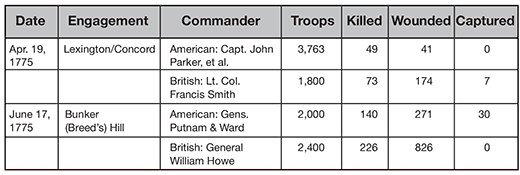
Based on this information, what was the mean value of men killed in both engagements? Write your answer below. (You may use a calculator to answer this question.)
14. The graph shows the changes in unemployment rates for nonfarm workers between 1926 and 1947.
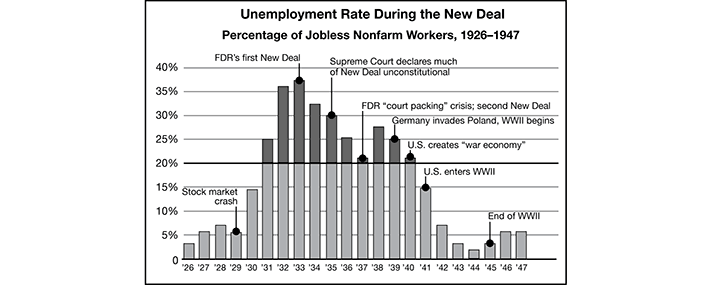
Based on the information shown, select the event that led to the greatest drop in the unemployment rate the following year for nonfarm workers.
a. FDR’s first New Deal
b. the United States enters World War II
c. the stock market crash
d. Germany invades Poland, World War II begins
15. Read the following definition of capitalism.
Capitalism is an economic and political system that allows a country’s trade and industry to be controlled by private owners for profit.
Based on this definition, write the appropriate word in the box that makes the following statement true.
Capitalism gives ______ owners the freedom to make a profit from control of the country’s trade and industry.
16. The graph shows the percentage of citizens affiliated with each U.S. political party.
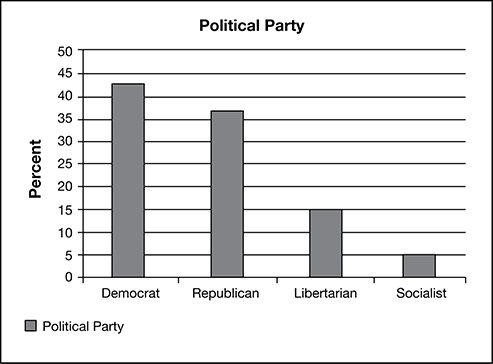
Which political party has the most members, and how does the graph show that?
a. The Democratic Party has the most members. Political parties are labeled on the x-axis, and the percent of members in those parties is labeled on the y-axis. The bar for percentage of Democrats is highest.
b. The Democratic Party has the most members. Political parties are labeled on the y-axis, and the percent of members in those parties is labeled on the x-axis. The bar for percentage of Democrats is highest.
c. The Libertarian Party has the most members. Political parties are labeled on the x-axis, and the percent of members in those parties is labeled on the y-axis. The bar for percentage of Libertarians is highest.
d. The Libertarian Party has the most members. Political parties are labeled on the y-axis, and the percent of members in those parties is labeled on the x-axis. The bar for percentage of Libertarians is highest.
17.
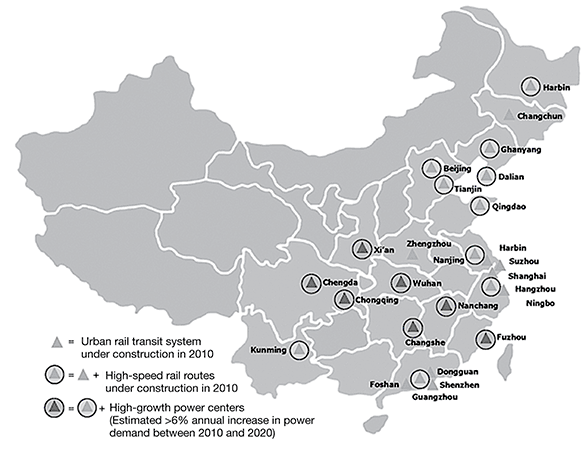
Based on this map of China, select the answer that correlates to a gray triangle surrounded by a circle.
a. urban rail transit system under construction in 2010
b. urban rail transit system and high-speed rail routes under construction in 2010
c. high-speed rail routes under construction in 2010
d. high-growth power centers
18. The graph shows the total campaign expenditures by candidates for the California State Legislature between 1975 and 1998.
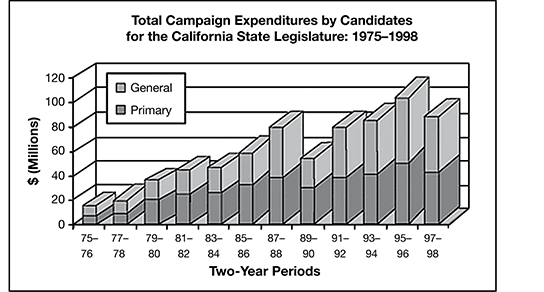
What was the trend in expenditures by candidates for the California State Legislature from 1983 to 1988?
a. decreasing
b. increasing then decreasing
c. decreasing then increasing
d. increasing
Please use the following passage to answer questions 19–20.
This excerpt is from a speech by Barack Obama announcing his candidacy for president in Springfield, Illinois, in 2007.
All of us know what those challenges are today—a war with no end, a dependence on oil that threatens our future, schools where too many children aren’t learning, and families struggling paycheck to paycheck despite working as hard as they can. We know the challenges. We’ve heard them. We’ve talked about them for years.
What’s stopped us from meeting these challenges is not the absence of sound policies and sensible plans. What’s stopped us is the failure of leadership, the smallness of our politics—the ease with which we’re distracted by the petty and trivial, our chronic avoidance of tough decisions, our preference for scoring cheap political points instead of rolling up our sleeves and building a working consensus to tackle big problems.
For the last six years we’ve been told that our mounting debts don’t matter, we’ve been told that the anxiety Americans feel about rising health care costs and stagnant wages are an illusion, we’ve been told that climate change is a hoax, and that tough talk and an ill-conceived war can replace diplomacy, and strategy, and foresight. And when all else fails, when Katrina happens, or the death toll in Iraq mounts, we’ve been told that our crises are somebody else’s fault. We’re distracted from our real failures, and told to blame the other party, or gay people, or immigrants.
And as people have looked away in disillusionment and frustration, we know what’s filled the void. The cynics, and the lobbyists, and the special interests who’ve turned our government into a game only they can afford to play. They write the checks and you get stuck with the bills, they get the access while you get to write a letter, they think they own this government, but we’re here today to take it back. The time for that politics is over. It’s time to turn the page.
19. Based on the excerpt from Obama’s speech announcing his candidacy for president, which of the following sets of words represents instances of loaded language?
a. hoax, frustration
b. today, decisions
c. void, lobbyists
d. page, diplomacy
20. The paragraph starting with “For the last six years . . .” could be viewed as an example of which of the following?
a. economic chart
b. campaign speech
c. statistical data
d. campaign promise
Please use the following passage to answer questions 21–22.
This is an excerpt from a speech about health care delivered to Congress by President Obama on September 9, 2009.
Then there’s the problem of rising cost. We spend one and a half times more per person on health care than any other country, but we aren’t any healthier for it. This is one of the reasons that insurance premiums have gone up three times faster than wages. It’s why so many employers, especially small businesses, are forcing their employees to pay more for insurance or are dropping their coverage entirely. It’s why so many aspiring entrepreneurs cannot afford to open a business in the first place and why American businesses that compete internationally, like our automakers, are at a huge disadvantage. And it’s why those of us with health insurance are also paying a hidden and growing tax for those without it, about $1,000 per year that pays for somebody else’s emergency room and charitable care.
Finally, our health care system is placing an unsustainable burden on taxpayers. When health care costs grow at the rate they have, it puts greater pressure on programs like Medicare and Medicaid. If we do nothing to slow these skyrocketing costs, we will eventually be spending more on Medicare and Medicaid than every other government program combined. Put simply, our health care problem is our deficit problem. Nothing else even comes close. Nothing else.
21. In the excerpt from Obama’s speech on health care, what type of statement is “we aren’t any healthier for it”?
a. supported fact
b. statistic
c. warning
d. opinion
22. According to the excerpt from Obama’s speech on health care, what does he think will be the eventual effect of unchecked added pressure being put on Medicare and Medicaid from rapidly increasing health-care costs?
a. the government spending less on Medicare and Medicaid than every other program combined
b. the government spending more on Medicare and Medicaid than every other program combined
c. the shutdown of Medicare and Medicaid instead of other programs
d. the government no longer spending any money on Medicare and Medicaid
23. Why did Christopher Columbus set sail in 1492 in an expedition that would eventually bring him into contact with the Americas for the first time?
a. He was attempting to claim new territory in the Americas for Spain.
b. He was going to the Americas to trade with the native peoples.
c. He was attempting to find a new route to Asia for trade purposes.
d. He was going to the Americas in order to start a settlement.
24. Based on the pie chart showing the number of women working in the U.S. military during World War II, fill in the box in the following statement to make it correct.
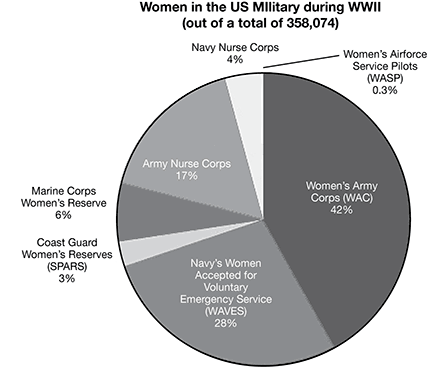
During World War II, the number of women who joined _____ was almost equal to the combined number of women who joined WASP, the Army and Navy Nurse Corps, SPARS, and the Marine Corps Women’s Reserve.
25. The map shows the division of European countries according to political alignment during most of the Cold War.
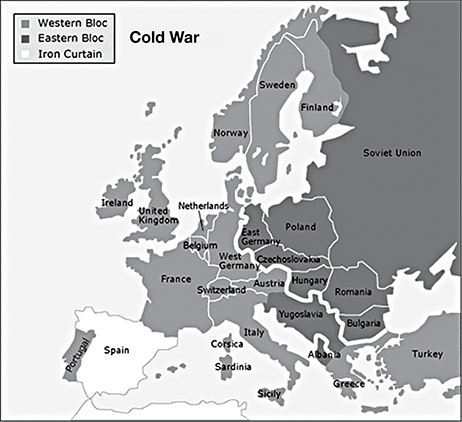
According to the map, how was Turkey aligned in this division?
a. with the Western Bloc
b. with the Eastern Bloc
c. with the Iron Curtain
d. with the United States
26. This excerpt is from a speech by George W. Bush given on March 19, 2008.
To ensure that military progress in Iraq is quickly followed up with real improvements in daily life, we have doubled the number of Provincial Reconstruction Teams in Iraq. These teams of civilian experts are serving all Iraqi—18 Iraqi Provinces, and they’re helping to strengthen responsible leaders and build up local economies and bring Iraqis together, so that reconciliation can happen from the ground up. They’re very effective. They’re helping give ordinary Iraqis confidence that by rejecting the extremists and reconciling with one another, they can claim their place in a free Iraq and build better lives for their families.
Based on the excerpt from Bush’s speech, you can infer which of the following is NOT a reason that it was important to have civilian expert teams in Iraq after the military action in the area?
a. to strengthen the local leadership and economy
b. to take control of the local leadership and economy
c. to help give confidence to the people of Iraq
d. to help the Iraqi people build a free Iraq
27. If a company purchases a product for $1 and sells it to consumers for $2.35, the $1.35 that the company receives is an example of what economic concept?
a. monopoly
b. expense
c. profit
d. loss
28. Write the word in the box that completes the following definition.
A _____ is a tax or duty a government places upon imported or exported goods.
29. This excerpt describes the eligibility requirements for a Stateside Union Bank College Credit Card.
To qualify for a Stateside Union Bank College Credit Card, a student must be at the age of majority in the state of residence, and show proof of enrollment in an accredited college or university.
Applicants must have a minimum income greater than $4,000. Applicants who do not meet this criterion will need a co-applicant with an ability to repay the debt.
Based on the excerpt, in which of the following situations would someone NOT qualify for the card?
a. aged 20, student at the University of Texas, income of $5,000
b. aged 14, high-school student, no income
c. aged 24, graduate student at Rice University, income of $11,000
d. aged 18, student at Baylor University, income of $4,250
30.
Government spending during war that is associated with wartime expenses has short-term positive economic benefits because high levels of spending associated with conflict increase economic growth. However, after the war is over, unintended residual effects of that heightened wartime spending, which is no longer taking place, tend to cause long-term impediments to economic prosperity.
Based on the information above, choose the best description of the economic effects of war.
a. short-term negative effects followed by positive long-term effects
b. wars produce neither positive nor negative economic effects
c. short-term positive effects followed by negative long-term effects
d. wars produce short-term and long-term negative effects
31. The graph below shows the correlation between metal exploration budgets in the United States and the prices of metals between 1989 and 2008.

Based on the graph, how did the price of gold and copper correlate to U.S. exploration spending from 2006 to 2008?
a. as the price of gold and copper increased, the amount that the U.S. spent on exploration increased
b. as the price of gold and copper increased, the amount that the U.S. spent on exploration decreased
c. as the price of gold and copper decreased, the amount that the U.S. spent on exploration increased
d. as the price of gold and copper decreased, the amount that the U.S. spent on exploration decreased
32. These two excerpts are taken from separate sources about the Industrial Revolution.
The era known as the Industrial Revolution was a period in which fundamental changes occurred in agriculture, textile and metal manufacture, transportation, economic policies and the social structure in England . . . The year 1760 is generally accepted as the “eve” of the Industrial Revolution. In reality, this eve began more than two centuries before this date. The late 18th century and the early 19th century brought to fruition the ideas and discoveries of those who had long passed on, such as, Galileo, Bacon, Descartes and others.
Industrial Revolution, in modern history, is the process of change from an agrarian, handicraft economy to one dominated by industry and machine manufacture. This process began in England in the 18th century and from there spread to other parts of the world.
What is the discrepancy between what is stated in these two passages?
a. the date of the 18th century as the time period
b. defining the time period as a time of fundamental change
c. the real start beginning two centuries before the 18th century
d. the revolution starting and growing in England
33. The map below shows the major ethnic regions of Pacific Asia.
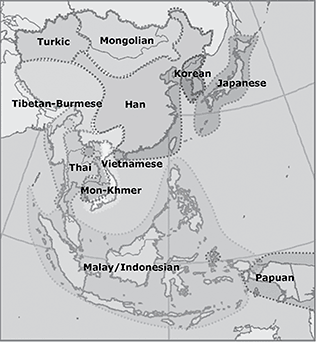
What is the label for the region on the map that covers one island that borders the Korean ethnic region and is located north of the Malay/Indonesian and Papuan ethnic regions?
a. Turkic
b. Thai
c. Han
d. Japanese
Please use the following maps to answer questions 34–35.
These maps are based on information from the U.S. Census Bureau.
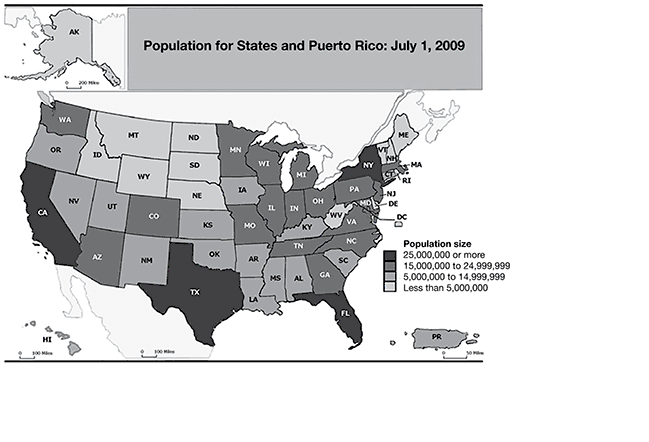
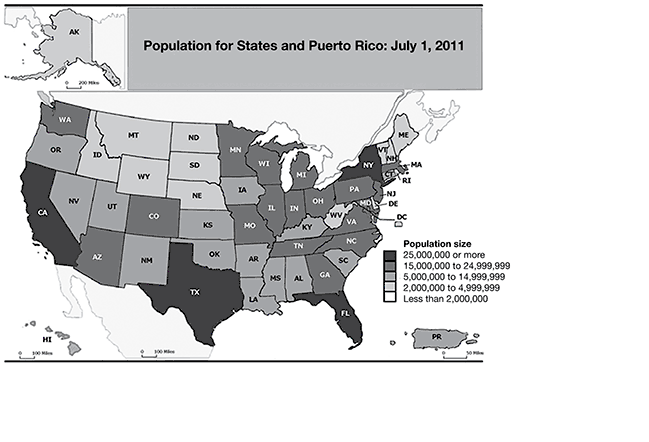
34. Based on the maps showing the population of American states in 2009 and 2011, what has been the population trend between those years for the state of Texas?
a. increased
b. stayed the same
c. decreased
d. increased then decreased
35. Based on the 2011 Census map, how does the population of California relate to the population of Texas?
a. population two categories larger than Texas
b. in the same population category as Tennessee
c. population two categories smaller than Texas
d. in the same population category as Texas
Part II
1 question
25 minutes to complete
This practice test will familiarize you with the Extended Response question found on the GED® Social Studies test.
Before you begin, it is important to note that on the official test, this task must be completed in no more than 25 minutes. But don’t rush to complete your response; take time to carefully read the passage(s) and the prompt. Then think about how you would like to respond to the prompt.
As you write your essay, be sure to:
• Develop an argument about how the ideas expressed by President Kennedy are related to the quotation from the Declaration of Independence
• Thoroughly construct your main points, organizing them logically, with strong supporting details
• Present multiple pieces of evidence, using ideas from the quotation and the excerpt
• Connect your sentences, paragraphs, and ideas with transitional words and phrases
• Express your ideas clearly and choose your words carefully
• Use varied sentence structures to increase the clarity of your response
• Reread and revise your response
Good luck!
Please use the following passages to answer the essay question.
This excerpt is from the Declaration of Independence.
We hold these truths to be self-evident, that all men are created equal, that they are endowed by their Creator with certain unalienable Rights, that among these are Life, Liberty, and the pursuit of Happiness.
This excerpt is from a speech on civil rights given by President John F. Kennedy on June 11, 1963.
This Nation was founded by men of many nations and backgrounds. It was founded on the principle that all men are created equal, and that the rights of every man are diminished when the rights of one man are threatened. Today we are committed to a worldwide struggle to promote and protect the rights of all who wish to be free. And when Americans are sent to Viet-Nam or West Berlin, we do not ask for whites only. It ought to be possible, therefore, for American students of any color to attend any public institution they select without having to be backed up by troops. It ought to be possible for American consumers of any color to receive equal service in places of public accommodation, such as hotels and restaurants and theaters and retail stores, without being forced to resort to demonstrations in the street, and it ought to be possible for American citizens of any color to register and to vote in a free election without interference or fear of reprisal. It ought to be possible, in short, for every American to enjoy the privileges of being American without regard to his race or his color. In short, every American ought to have the right to be treated as he would wish to be treated, as one would wish his children to be treated. But this is not the case. The Negro baby born in America today, regardless of the section of the Nation in which he is born, has about one-half as much chance of completing a high school as a white baby born in the same place on the same day, one-third as much chance of completing college, one-third as much chance of becoming a professional man, twice as much chance of becoming unemployed, about one-seventh as much chance of earning $10,000 a year, a life expectancy which is 7 years shorter, and the prospects of earning only half as much. This is not a sectional issue. Difficulties over segregation and discrimination exist in every city, in every State of the Union, producing in many cities a rising tide of discontent that threatens the public safety. Nor is this a partisan issue. In a time of domestic crisis men of good will and generosity should be able to unite regardless of party or politics. This is not even a legal or legislative issue alone. It is better to settle these matters in the courts than on the streets, and new laws are needed at every level, but law alone cannot make men see right. We are confronted primarily with a moral issue. It is as old as the scriptures and is as clear as the American Constitution.
QUESTION:
In your response, develop an argument about how President Kennedy’s stance on the civil-rights issues of the time reflected beliefs that were already built into the section of the Declaration of Independence quoted here, even though the Declaration of Independence was written centuries before civil rights for African Americans became a national focus. Incorporate relevant and specific evidence from the two excerpts and your knowledge of the enduring issue and circumstances surrounding the Civil-rights movement to support your analysis.
Answers and Explanations
Part I
1. Choice b is correct. The liberation of the Iraqi people from a brutal ruling regime and the removal of Hussein from power are both goals that would have the ability to bring about all of the changes for Iraq that President Bush mentions came about after the success of the operation. Therefore, it is safe to say that this choice represents the main purpose of the launching of the operation by President Bush.
Choice a is incorrect. While the liberation of Baghdad led to Operation Iraqi Freedom’s success, it alone was not the purpose of the operation. The capture of this one city would not have been enough to bring about the other changes and freedoms for the Iraqi people that Bush mentions, such as those in the excerpt’s final paragraph.
Choice c is incorrect. Stopping Hussein from invading nations was an outcome of the operation’s success in removing Hussein from power not the actual purpose of the operation. That purpose would be to remove Hussein, which would result in this beneficial outcome.
Choice d is incorrect. These nations joined forces for the common cause of the operation to stop Saddam Hussein’s control of the Iraqi people’s natural rights.
2. Choice d is correct. This statement is an opinion held and expressed by Bush. He uses the term “remarkable,” which is inherently a term of opinion. Bush may feel that the operation “was a remarkable display of military effectiveness,” but this is an opinion, not a fact.
Choice a is incorrect. All of these events are facts that are confirmed by the actions and technicalities of the operation. All of these actions were actually carried out during the operation.
Choice b is incorrect. This is once again a fact. These forces did all join with the U.S. in the beginning of the operation.
Choice c is incorrect. This is another fact of the actions carried out during the operation when troops actually did battle Saddam’s death squads.
3. Choice c is correct. All of the atrocities carried out by Saddam that Bush mentions in his speech serve to show the justification for the operation and show just how brutal Saddam’s regime was and how detrimental it was to the citizens of that regime who were exposed to atrocities. Bush mentions in the end all the negative things that have been stopped due to the operation, once again bolstering its justification.
Choice a is incorrect. Everything that Bush says about the operation in this part of his speech implies that the operation was justified and successful. He mentions on many occasions the brutality of Saddam’s regime and gives examples. He then goes on to list atrocities that have been stopped due to the operation.
Choice b is incorrect. Everything that Bush says would imply that he feels the operation was justified. However, the realities of Saddam’s regime that Bush mentions only lend credit to this justification. Instead of discrediting the operation, the atrocities that Saddam imposed on his people only bolster the idea that it was justified.
Choice d is incorrect. While the atrocities of Saddam’s regime that Bush mentions justify the operation, Bush does not disagree with that justification. The fact that he mentions all of said atrocities implies that he agrees that the operation was justified, and in the last paragraph he goes on to mention all of the atrocities that have been stopped due to the operation. He never expresses any doubts about the operation’s justification.
4. Choice c is correct. The legislative branch involves the Senate and the House of Representatives, and the executive branch consists of the president and his administration. The fact that the Senate must have a two-thirds agreement in order to allow the president to make a treaty means that the legislative branch is checking the power of the executive branch so that the president does not have full and unopposed power to make treaties.
Choice a is incorrect. The president is part of the executive branch, and that branch is not checking the powers of any other branches but actually having its own powers checked.
Choice b is incorrect. The judicial branch involves the courts, and this branch is not even mentioned in this section of the Constitution.
Choice d is incorrect. The judicial branch does not even factor into this section of the Constitution.
5. Choice b is correct. The system of checks and balances in the U.S. government is meant to separate the powers of the branches of government and provide a balance to those powers so that one person or group does not hold all power, which could then be abused and exploited.
Choice a is incorrect. The idea behind checks and balances between the branches of government is to keep a balance of power, not to allow the legislative branch to have power over the executive or judicial branches. In the excerpt, this check on the power of the president does not imply that the Senate has power over the president or courts, but rather it is a balance of power.
Choice c is incorrect. If the president had the ability to check the power of all the other branches, his power would be more like a dictatorship than a presidency. The system of checks and balances is meant to prevent this. Also, the excerpt shows that the president does not have this power due to the fact that the Senate is actually checking the president’s power in this example.
Choice d is incorrect. While the example in the excerpt does refer to this check on the power of the president, this is only an example of one instance of checks and balances in the U.S. government and not the actual point of this system. There are many other examples of checks and balances written into the U.S. Constitution.
6. Choice c is correct. Without a two-thirds agreement in the Senate, the president cannot make a treaty. This is part of the system of checks and balances in the U.S. government. It is a check on the power of the executive branch.
Choice a is incorrect. The president is the one who makes treaties with the consent of the Senate. Therefore, failure to receive a two-thirds agreement would make a treaty impossible, not just in the Senate but for the president as well.
Choice b is incorrect. The Senate does not make the treaties; the president does. The Senate consults with the president and must agree with the treaty in order for it to be made.
Choice d is incorrect. Without a two-thirds agreement in the Senate, the president cannot make a treaty. This is part of the system of checks and balances in the U.S. government. It is a check on the power of the executive branch.
7. Choice a is correct. The concept of popular sovereignty implies that the government holds authority through the consent of the governed, and if the governed fails to approve of said authority, the people can change it. A dictatorship does not take the consent of the governed into account, and one individual rules without consent.
Choice b is incorrect. The concept of popular sovereignty implies that the government holds authority through the consent of the governed and if the governed fails to approve of said authority, the government can change it. A dictatorship does not take the consent of the governed into account and one individual rules without consent.
Choice c is incorrect. The concept of popular sovereignty does not necessarily mean that the government is run by the most popular person, but rather that the leader of the government has consent of the governed. A dictatorship does not necessarily mean that the government is run by the least popular person, but rather that said person does not take the consent of the governed into account.
Choice d is incorrect. A dictatorship does not mean that the government is run by the most popular person, but rather that the leader of the government does not take the consent of the government into account. The concept of popular sovereignty does not mean that the government is run by the least popular person, but rather that said person has the consent of the governed.
8. The executive branch is made up of the president and the president’s Cabinet.
The legislative branch is made up of the Senate and the House of Representatives, collectively known as Congress.
The judicial branch is made up of the Supreme Court.
9. Choice b is correct. Right at the beginning of the excerpt, Clinton references the problems of discrimination from the past and says that it continues to plague the country. He makes it apparent that affirmative action is a way to lessen this discrimination and hopefully solve many problems that it creates for minority groups.
Choice a is incorrect. Slavery was a problem that has been abolished by law since the Civil War and Reconstruction. Affirmative action is not addressing slavery or a solution.
Choice c is incorrect. While unemployment can be caused by discrimination, affirmative action addresses discrimination, which could then inadvertently help with unemployment as a side effect. Affirmative action is not directly addressing unemployment or providing a direct solution to it.
Choice d is incorrect. While poverty can be caused by discrimination, affirmative action addresses discrimination, which could then inadvertently help with unemployment and poverty as a side effect. Affirmative action is not directly addressing poverty or providing a direct solution to it.
10. Choice a is correct. According to Clinton, affirmative action will benefit minority groups “by building the pool of qualified applicants for college, for contracts, for jobs, and giving more people the chance to learn, work, and earn. When affirmative action is done right, it is flexible, it is fair, and it works.”
Choice b is incorrect. This change is the opposite of the purpose of affirmative action and is the opposite of the correct answer. According to Clinton, affirmative action will benefit minority groups “by building the pool of qualified applicants for college, for contracts, for jobs, and giving more people the chance to learn, work, and earn. When affirmative action is done right, it is flexible, it is fair, and it works.”
Choice c is incorrect. Clinton mentions that the idea to have penalties for employers who fail to meet high quotas was actually rejected and affirmative action helps to keep this from happening. However, affirmative action has as its main goal the improvement of conditions for minority groups. Therefore, the idea that it would not change anything for minority groups is wrong.
Choice d is incorrect. Both of these statements represent things that affirmative action is trying to fix. Affirmative action would increase the amount of minority groups in college, not decrease their numbers. According to Clinton, affirmative action will benefit minority groups “by building the pool of qualified applicants for college, for contracts, for jobs, and giving more people the chance to learn, work, and earn. When affirmative action is done right, it is flexible, it is fair, and it works.”
11. Choice d is correct. Both excerpts mention the importance of liberty for all citizens. The Declaration of Independence says all men have the right to liberty, and the Constitution says that the government must “secure the Blessings of Liberty to ourselves and our Posterity.”
Choice a is incorrect. The concept of all men being equal is mentioned only in the excerpt from the Declaration of Independence.
Choice b is incorrect. This idea is mentioned only in the excerpt from the Declaration of Independence.
Choice c is incorrect. Neither excerpt mentions anything about slavery or the need to abolish it. Furthermore, the Declaration of Independence was made during a time when slavery was still very prominent.
12. Choice b is correct. Popular sovereignty refers to a government run by the people, where the people have the ability to affect, change, and replace their government as they see fit. This is what the excerpt is essentially describing.
Choice a is incorrect. Federalism refers to the concept of a federal government. This excerpt references the ability to replace the government; it doesn’t describe a federal system of government.
Choice c is incorrect. Socialism deals with a centralized control of wealth in order to make the spread of wealth more equal. This has nothing to do with the ability to replace the government. The term socialism is not preceded by the word popular.
Choice d is incorrect. Capitalism deals with the idea of free markets and private ownership in the economy. This is an economic system, not a system of replacing a destructive form of government.
13. The correct answer is 122.
The mean is the average. Therefore, you add up all of the numbers in the column listing the number of men killed: 49 + 73 + 140 + 226 = 488.
Then divide the answer by the number of values given: 488/4 = 122.
14. Choice b is correct. The United States entering World War II took the rate from 14.5% in 1941 to 7% in 1942, or a 7.5% decrease.
Choice a is incorrect. FDR’s first New Deal took the rate from 37% in 1933 to 33% in 1934, or a 4% drop. This was not the largest decrease.
Choice c is incorrect. The stock market crash increased the unemployment rate by 9%, from 5.5% in 1929 to 14.5% in 1930.
Choice d is incorrect. In the year following the German invasion of Poland, the unemployment rate dropped from 25% to 21%, or a 4% drop. This was not the largest decrease.
15. The answer is private, based on an understanding and comprehension of the definition and logical reasoning to understand how it can fit into the statement.
16. Choice a is correct. The Democrat bar is the highest and is shown on the graph with political parties being labeled on the x-axis (horizontally) and the percentage of members labeled along the y-axis (vertically). This allows a viewer to see that the Democratic Party has the highest percentage of members.
Choice b is incorrect. While the Democratic Party does have the most members based on the percentages, the political parties are labeled on the x-axis, not the y-axis. Also, percentages are labeled on the y-axis, not the x-axis.
Choice c is incorrect. While the political parties are labeled on the x-axis and percentages are labeled on the y-axis, which shows, through the use of bars, which party has the most members, the Libertarian Party does not have the highest bar. Therefore, it does not have the most members.
Choice d is incorrect. The Libertarian Party does not have the highest bar representing percentage of members and consequently does not have the most members. Also, political parties are labeled on the x-axis, not the y-axis, and percentages are labeled on the y-axis, not the x.
17. Choice b is correct. The key indicates that a circle surrounding a gray triangle includes both “urban rail transit system under construction in 2010” and “high-speed rail routes under construction in 2010.”
Choice a is incorrect. The symbol for “urban rail transit system under construction in 2010” is a simple gray triangle.
Choice c is incorrect. The key indicates that a circle surrounding a gray triangle includes both “urban rail transit system under construction in 2010” and “high-speed rail routes under construction in 2010.”
Choice d is incorrect. High-growth power centers are designated by a circle surrounding a black triangle.
18. Choice d is correct. The bars indicating expenditures for that time period are increasing. They increase from around $40 million to $80 million based on the dollar amount labeled on the y-axis (vertical) and years labeled on the x-axis (horizontal).
Choice a is incorrect. The bars indicating expenditures for that time period are not decreasing. They increase from around $40 million to $80 million based on the dollar amount labeled on the y-axis (vertical) and years labeled on the x-axis (horizontal).
Choice b is incorrect. The bars indicating expenditures for that time period are increasing, but they never decrease during that time. They increase from around $40 million to $80 million based on the dollar amount labeled on the y-axis (vertical) and years labeled on the x-axis (horizontal).
Choice c is incorrect. The bars indicating expenditures for that time period are increasing, and they never decrease during that time. They increase from around $40 million to $80 million based on the dollar amount labeled on the y-axis (vertical) and years labeled on the x-axis (horizontal).
19. Choice a is correct. Loaded language means language that is highly emotive and used to gain support, sway emotions, degrade others, or push an agenda. Hoax and frustration are words that are being used by Obama to sway voters against the previous political administration in order to win the presidency in the coming election.
Choice b is incorrect. Loaded language means language that is highly emotive and used to gain support, sway emotions, degrade others, or push an agenda. Today and decisions are not words that serve this purpose in this excerpt.
Choice c is incorrect. Loaded language means language that is highly emotive and used to gain support, sway emotions, degrade others, or push an agenda. Void and lobbyists are not words that serve this purpose in this excerpt.
Choice d is incorrect. Loaded language means language that is highly emotive and used to gain support, sway emotions, degrade others, or push an agenda. Page and diplomacy are not words that serve this purpose in this excerpt.
20. Choice b is correct. Obama is publicizing a point of view or political cause. He does not acknowledge who has been telling Americans this but implies that it is coming from members of the government. Obama wants to replace these members by hopefully winning the presidency. This speech announces his political campaign for president.
Choice a is incorrect. Obama is stating his opinions. Obama wants the people hearing him to feel he is right about these issues. He does not present an economic chart.
Choice c is incorrect. Obama is stating his opinions. Obama wants the people hearing him to feel he is right about these issues. He does not present statistical facts.
Choice d is incorrect. The third paragraph of Obama’s speech does not mention anything that he promises to do when he becomes president.
21. Choice d is correct. In the excerpt, Obama does not give any factual evidence to support this statement. Therefore it falls into the category of an opinion or unsupported claim.
Choice a is incorrect. In the excerpt, Obama does not give any factual evidence to support this statement.
Choice b is incorrect. A statistic is a piece of data that typically comes from a study involving a large amount of numerical data. Obama does not mention any numbers in this statement.
Choice c is incorrect. Obama’s statement is not a warning that something will happen.
22. Choice b is correct. If Medicare and Medicaid are struggling, then the government would have to spend more on them in order to help the programs. Obama explicitly says, “we will eventually be spending more on Medicare and Medicaid than every other government program combined.”
Choice a is incorrect. If Medicare and Medicaid are struggling, then the government would have to spend more on them in order to help the programs, not less. Obama explicitly says, “we will eventually be spending more on Medicare and Medicaid than every other government program combined.”
Choice c is incorrect. While Obama mentions that Medicare and Medicaid are struggling due to rapidly increasing health care costs, he never mentions that this would lead to the shutdown of these programs. As government programs, it is much more likely that the government would spend more money on them instead of shutting them down. Also, due to the fact that so many people rely on these programs, it would take a lot more to actually shut them down.
Choice d is incorrect. This is the exact opposite of what Obama implies will happen. As government programs, the government would spend more money on them to help them when they are struggling. If the government stopped spending money on them, their struggles would increase to the point where they could no longer function. Also, Obama explicitly says, “we will eventually be spending more on Medicare and Medicaid than every other government program combined.”
23. Choice c is correct. This was the goal of his expedition in 1492. The spice trade was very lucrative at the time, and Columbus had the idea that he could sail in the direction of the Americas and eventually reach Asia, thereby avoiding overland trade routes in the other direction. He did not realize that there was a large landmass in the way, and this is how he discovered the Americas.
Choice a is incorrect. Columbus’ first expedition in 1492 had nothing to do with finding new territory. He did not know that the Americas existed since this expedition brought him into contact with the land for the first time. While he did eventually make future expeditions to the Americas on behalf of Spain, this was after he knew it existed.
Choice b is incorrect. He did not know that the Americas existed since this expedition brought him into contact with the land for the first time. While he did eventually make future expeditions to the Americas for goods on behalf of Spain, he could not be planning an expedition to trade with native peoples who he did not know existed.
Choice d is incorrect. Columbus’ first expedition in 1492 had nothing to do with creating a new settlement for Spain in the Americas. He did not know that the Americas existed since this expedition brought him into contact with the land for the first time, and he could not be looking to make a settlement in a place he didn’t know existed. While he did eventually make future expeditions to the Americas on behalf of Spain, this was after he knew it existed.
24. The correct answer is Navy’s Women Accepted for Voluntary Emergency Service, or WAVES.
Based on the pie chart, 0.3% of the women joining the military during World War II were Women’s Airforce Service Pilots or WASP, 4% were Navy Nurse Corps, 17% were American Nurse Corps, 6% were Marine Corps Women’s Reserves and 3% were Coast Guard Women’s Reserves or SPARS. The combination of all of those percentages comes out to 30.3% of women joining the military. This is closest to the 28% of the Navy’s Women Accepted for Voluntary Emergency Service rather than the 42% that was the Women’s Army Corps.
25. Choice a is correct. The map shows countries in the Eastern Bloc in darker gray and the Western Bloc in lighter gray. Turkey is colored lighter gray and is, therefore, part of the Western Bloc.
Choice b is incorrect. The map shows countries in the Eastern Bloc in darker gray and the Western Bloc in lighter gray. Turkey is colored lighter gray and is, therefore, part of the Western Bloc.
Choice c is incorrect. The Iron Curtain is a dividing line. Therefore, it is not one of the divisions that countries could be put into during the Cold War. It is shown as a white line, which Turkey only barely touches.
Choice d is incorrect. This map does not give any information about Turkey’s relationship with the United States. The United States is not depicted on the map.
26. Choice b is correct. Bush never mentions that the goal is to control the local leadership and economy in Iraq, but rather the goal is to help the Iraqi people eventually be able to completely control their own government. Therefore, this is not a reason that it was important to have civilian experts in Iraq.
Choice a is incorrect. Bush explicitly states, “they’re helping to strengthen responsible leaders and build up local economies.” Therefore, this choice is a reason that it was important to have civilian experts in Iraq.
Choice c is incorrect. Bush explicitly states, “they’re helping give ordinary Iraqis confidence.” Therefore, this choice is a reason that it was important to have civilian experts in Iraq.
Choice d is incorrect. Bush explicitly states, “they can claim their place in a free Iraq.” Therefore, this choice is a reason that it was important to have civilian experts in Iraq.
27. Choice c is correct. A profit is a financial gain. Since the company only spent $1 on the product and then sold it for $2.35 to consumers, the company makes a financial gain of $1.35 every time that a consumer purchases the product. The company makes a profit of $1.35.
Choice a is incorrect. A monopoly is an entity that has exclusive control over a product or service. A dollar amount cannot be an example of something that has complete control over a product or service. Also, the example gives no indication that the company has exclusive control of the product.
Choice b is incorrect. The $1.35 would only be a part of the expense for the consumer, not an expense for the company. The company’s only expense was the $1 that it spent on the product before selling it.
Choice d is incorrect. Since the company only spent $1 on the product and then sold it for $2.35 to consumers, the company makes a financial gain of $1.35 every time that a consumer purchases the product. The company makes a profit of $1.35, not a loss.
28. The correct answer is tariff.
A tariff is a tax or duty placed on imports or exports.
29. Choice b is correct. The person in this situation would not qualify for the card. He or she is not old enough, is a high school student not a college student, and does not have an income greater than $4,000.
Choices a, b, and c are incorrect. The people in these situations would qualify for the card. They are old enough, are students of an accredited university, and have an income greater than $4,000.
30. Choice c is correct. The excerpt mentions that the economy benefits in the short-term from substantial spending increases during the conflict; however, this leads to negative residual effects that hurt the economy in the long term after the war is over and there is no longer a spending boom related to the conflict.
Choice a is incorrect. The excerpt mentions that the economy benefits in the short-term from substantial spending increases during the conflict; however, this leads to negative residual effects that hurt the economy in the long term after the war is over and there is no longer a spending boom related to the conflict.
Choice b is incorrect. The excerpt mentions that the economy benefits in the short-term from substantial spending increases during the conflict; however, this leads to negative residual effects that hurt the economy in the long term after the war is over and there is no longer a spending boom related to the conflict. Therefore, wars definitely have economic effects.
Choice d is incorrect. The excerpt mentions that the economy benefits in the short-term from substantial spending increases during the conflict; however, this leads to negative residual effects that hurt the economy in the long term after the war is over and there is no longer a spending boom related to the conflict. The effects are not all negative due to the positive short-term effects.
31. Choice a is correct. Dark gray bars represent the amount that the U.S. spent on metal exploration. The two lines represent the price of gold and copper. Based on this information, between the years of 2006 and 2008 the prices of gold and copper along with U.S. spending on metal exploration all increased.
Choices b, c, and d are incorrect. Dark gray bars represent the amount that the U.S. spent on metal exploration. The two lines represent the price of gold and copper. Based on this information, between the years of 2006 and 2008 the prices of gold and copper along with U.S. spending on metal exploration all increased.
32. Choice c is correct. The quote from the first source says, “in reality, this eve began more than two centuries before this date,” while the quote from the second source does not mention this idea.
Choice a is incorrect. Both quotes mention that the time period of the Industrial Revolution was in the 18th century.
Choice b is incorrect. Both quotes define the Industrial revolution as a time of great change. “The era known as the Industrial Revolution was a period in which fundamental changes occurred” and “Industrial Revolution, in modern history, is the process of change from an agrarian, handicraft economy to one dominated by industry and machine manufacture.”
Choice d is incorrect. Both sources mention that England is where the Industrial Revolution began and grew. “The era known as the Industrial Revolution was a period in which fundamental changes occurred in agriculture, textile and metal manufacture, transportation, economic policies and the social structure in England” and “This process began in England in the 18th century and from there spread to other parts of the world.”
33. Choice d is correct. The Japanese region covers an island, borders the Korean region, and is north of the Malay/Indonesian and Papuan regions.
Choice a is incorrect. The Turkic region is above the Malay/Indonesian and Papuan regions, but it is not covering an island and does not border the Korean region.
Choice b is incorrect. The Thai region is above the Malay/Indonesian and Papuan regions, but it is not covering an island and does not border the Korean region.
Choice c is incorrect. The Han region is above the Malay/Indonesian and Papuan regions and borders the Korean region, but it is not covering an island.
34. Choice a is correct. The map key shows that states labeled with the darkest gray have a population size of 25,000,000 or more, and the states labeled with one shade lighter have a population size of 15,000,000 to 24,999,999. In the 2009 map, Texas is colored the second to darkest shade and in the 2011 map it is colored the darkest shade. Therefore, its population increased from the 15,000,000–24,999,999 range to the 25,000,000 or more range.
35. Choice d is correct. Texas and California are both colored the darkest shade of gray, representing a population of 25,000,000 or more. Therefore, the population of California is in the same category as the population of Texas according to the information given in the map.
Choice a is incorrect. California does not have a larger population than Texas. Both are colored the darkest shade of gray, representing a population of 25,000,000 or more. Therefore the population of California is in the same category as the population of Texas according to the information given in the map. The map does not show exact population numbers, so there is no way to determine which one actually has a slightly larger or smaller population.
Choice b is incorrect. Texas and California are both colored the darkest shade of gray, representing a population of 25,000,000 or more. Tennessee has a smaller population than either Texas or California.
Choice c is incorrect. Texas and California are both colored the darkest shade of gray, representing a population of 25,000,000 or more. Therefore, the population of California is in the same category as the population of Texas according to the information given in the map. The map does not show exact population numbers, so there is no way to determine which one actually has a slightly larger or smaller population.
Part II
Your Extended Response will be scored based on three traits, or elements:
Trait 1: Creation of arguments and use of evidence
Trait 2: Development of ideas and organizational structure
Trait 3: Clarity and command of standard English conventions
Your essay will be scored on a 4-point scale—Trait 1 is worth 0–2 points, and Traits 2 and 3 are worth 0–1 point.
Trait 1 tests your ability to write an essay that takes a stance and makes an argument based on the information in the passages. To earn the highest score possible, you must carefully read the information and express a clear opinion on what you have read. You will be scored on how well you use the information from the passages to support your argument. Your response will also be scored on how well you analyze the information in the passages.
For your reference, here is a table that readers will use when scoring your essay with a 2, 1, or 0.
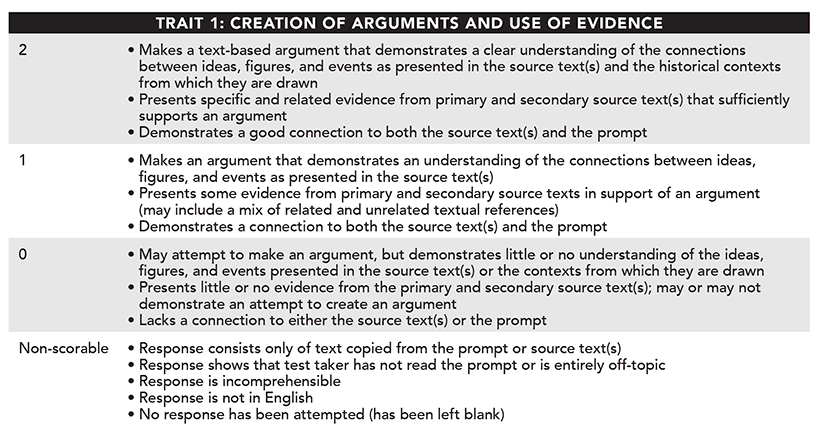
Trait 2 tests whether you respond to the writing prompt with a well-structured essay. Support of your thesis must come from evidence in the passages, as well as personal opinions and experiences that build on your central idea. Your ideas must be fully explained and include specific details. Your essay should use words and phrases that allow your details and ideas to flow naturally. Here is a table that outlines what is involved in earning a score of 1 or 0.
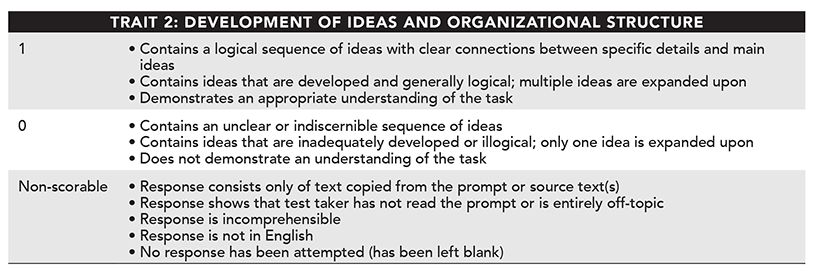
Trait 3 tests how you create the sentences that make up your essay. To earn a high score, you will need to write sentences with variety—some short, some long, some simple, some complex. You will also need to prove that you have a good handle on standard English, including correct word choice, grammar, and sentence structure. Here is a table that outlines what is involved in attaining a score of a 1 or 0.
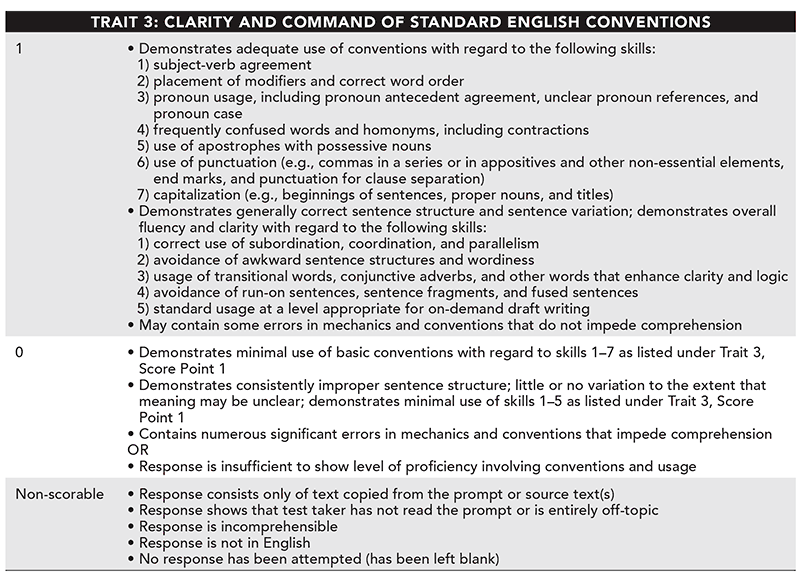
Sample Score 4 Essay
Although equal civil rights for all Americans, regardless of race, were not guaranteed by law until the 1960s, the same ideals that inspired the civil rights movement were part of the basic structure of American government from its creation, nearly two centuries before. While cultural, economic, and political factors may have interfered with the achievement of this goal for many years, its inclusion in the founding documents of the nation underlines the enduring nature of this issue.
The Declaration of Independence is widely regarded as the first formal expression of American democracy. The document states that “all men are created equal,” and refers to “certain unalienable rights,” meaning that these basic rights cannot be taken away. While the United States was not the first nation to suggest that citizens should be given basic rights, it was undoubtedly one of the first to support the notion of equal rights for all citizens. This extended basic protections to even the lowest classes of society, and also held the higher classes accountable to the same laws as everyone else.
At the time the Declaration of Independence was written, the idea that “all men are created equal” was, in many ways, difficult to implement in its purest form. Slaves were not considered as equals, and were in fact treated by the law as property; women were also excluded from many of the basic protections and rights that men enjoyed. Even among free white men, the application of equality was inconsistent at best. For example, in the nation’s first elections, only wealthy, land-owning men were allowed to vote.
The history of the United States is a history of edging ever closer to the ideals expressed in the Declaration of Independence and the U.S. Constitution. The obstacles that have impeded this progress have been economic and social factors such as slavery and prejudice. When slavery ended in the mid-nineteenth century, the U.S. Congress passed constitutional amendments intended to protect the voting rights and citizenship of former slaves. However, as Kennedy stated, “law alone cannot make men see right.” These laws, despite their intent, proved ineffective at preserving the rights of African Americans in many situations. For example, many parts of the country established separate facilities for blacks such as schools, bathrooms, and even drinking fountains. However, these facilities rarely met the same standards as those for whites. This sort of fundamental racial discrimination led to conditions like the ones Kennedy lists in his speech: African Americans were likely to be poorer, less educated, and to die sooner than white Americans. This is why Kennedy supported new civil rights legislation intended to strengthen protections of the rights of all people, regardless of race—bring the United States one step closer to the dream of a nation where, indeed, all men are created equal.
About this essay:
This essay has earned the maximum number of points in each trait for a total of 4 points.
Trait 1: Creation of Arguments and Use of Evidence
The sample response presents an argument about the role of equality in the Civil-rights movement and how it relates to the very beginnings of the founding of the U.S., even though the founding fathers did not yet realize that the idea of equality would be used in this way. The test taker’s argument cites multiple ideas from the source texts that bolster his or her position. Additionally, the writer incorporates into the response background knowledge about the importance of equality throughout U.S. history in general, and the role of equality in the Civil-rights movement in particular. Taken as a whole, the response offers an argument that is closely aligned to what is directed by the prompt and is well supported by the source texts.
Trait 2: Development of Ideas and Organizational Structure
This response earns one point in Trait 2 because it makes clear and understandable connections between ideas and establishes a progression in which one idea logically leads into the next, starting from the very beginning Although equal civil rights for all Americans, regardless of race, were not guaranteed by law until the 1960s, the same ideals that inspired the civil rights movement were part of the basic structure of American government from its creation, nearly two centuries before.
The main points are fully developed with multiple details given in support of each. Additionally, this response applies the level of formality appropriate for communicating in either workplace or academic settings, while also keeping in mind the purpose of the task, which is to present a well-supported argument.
Trait 3: Clarity and Command of Standard English Conventions
This response earns one point on Trait 3 because it effectively applies standard English language usage and conventions to convey ideas with clarity. In general, the response contains minimal mechanical errors, and the errors that do exist do not impede readers’ understanding. The response contains language appropriate for expressing its ideas and thoughtfully composed sentences that generally avoid wordiness and awkwardness. Additionally, clarity and flow of the response are enhanced with varied sentence structure and appropriate application of transitional words and phrases to connect sentences, paragraphs, and ideas.
Remember, however, because the Extended Response question on the GED® Social Studies test asks for a draft written in approximately 25 minutes, there is no expectation that your response be completely free of convention and usage errors.
Sample Score 2 Essay
In Kennedy’s speech, he states that “every American ought to have the right to be treated as he would wish to be treated, as one would wish his children to be treated.” This idea directly reflects the beliefs held by the Founding Fathers, as evidenced in the statement “all men are created equal” found in the declaration of independence.
For a number or reasons at the time of the signing of the declaration of independence “all men” did not include slaves and women. At the time of Kennedy’s speech, Africans Americans still weren’t being treated as equals in America, especially in the south. I know this is true because my grandmother lived in Mississippi during that time. Kennedy also states in his speech how African Americans were poorer and did not live as long as white people.
Kennedy argued that the issue of equality is a moral one that goes all the way back to the Constitution. Actually, it goes back to the declaration of independence, which came first and says “all men are created equal.” So he supported new laws to make sure that people all other races were all treated fairly. This was exactly what the Founding Fathers argued in favor of, even though they couldn’t really do it themselves at the time.
About this essay:
This essay has earned 1 of 2 possible points in Trait 1, 0 points in Trait 2, and 1 point in trait 3, for a total of 2 out of the 4 maximum points.
Trait 1: Creation of Arguments and Use of Evidence
This somewhat brief response offers an argument that demonstrates an understanding of how the enduring issue of equality for all men is presented in both of the excerpts: [Kennedy’s]idea directly reflects the beliefs held by the Founding Fathers, as evidenced in the statement “all men are created equal” found in the declaration of independence.
The writer also provides some evidence from both excerpts; for example, in the third paragraph: He argues that the issue of equality is a moral one that goes all the way back to the Constitution. Actually, it goes back to the declaration of independence, which came first and says “all men are created equal.” However, the writer also interjects a personal aside unrelated to the excerpts about his or her grandmother.
Though this brief sample response is connected to the prompt and the excerpts, it does not offer much information beyond what is presented in the excerpts about the enduring issue of equality or the civil-rights movement in the 1960s, so it earns only one point in this trait.
Trait 2: Development of Ideas and Organizational Structure
This response does not earn a point in Trait 2. Though it does demonstrate an understanding of the task, the sequence of ideas is unclear and only limited ideas are developed. For example, the writer begins the second paragraph with: For a number or reasons at the time of the signing of the declaration of independence “all men” did not include slaves and women. But he or she does elaborate upon those reasons other than at the closing of the essay: even though [the Founding Fathers] couldn’t really do it themselves at the time.
Trait 3: Clarity and Command of Standard English Conventions
This response earns one point on Trait 3. In general, the response contains minimal mechanical errors (though, glaringly, the writer does not capitalize Declaration of Independence throughout), however these errors that do not impede readers’ understanding. The response contains appropriate language for expressing its ideas and thoughtfully composed sentences that generally avoid wordiness and awkwardness.
Sample Score 0 Essay
The foundling fathers beleived that all man were created equal and we all have rights. I beleive this too and so does JFK.
JFK said we are committed to a worldwide struggle to promote and protect the rights of all who wish to be free. Laws needed to be passed JFK he passed them and the world is better today.
Difficulties over segregation and discrimination exist in every city, in every State of the Union, producing in many cities a rising tide of discontent that threatens the public safety. Nor is this a partisan issue. In a time of domestic crisis men of good will and generosity should be able to unite regardless of party or politics. This is not even a legal or legislative issue alone.
About this essay:
This essay earns a score of 0 in each of the three traits.
Trait 1: Creation of Arguments and Use of Evidence
This sample response earns a score of 0 in Trait 1. It is extremely brief, is composed mostly of direct quotations or paraphrases from the excerpts, and attempts an argument that is barely connected to the ideas in the excerpts: The foundling fathers beleived that all man were created equal and we all have rights. I beleive this too and so does JFK. Therefore, it is not sufficiently connected to the prompt.
Trait 2: Development of Ideas and Organizational Structure
This sample response also earns a score of 0 in Trait 2. The organizational structure is scattered and the progression of the one idea (Kennedy recognized the need to pass laws for equality) is barely discernible.
Trait 3: Clarity and Command of Standard English Conventions
This sample response also earns a score of 0 in Trait 2. The bulk of the response is composed of text lifted directly from the excerpts, with the exceptions of the first paragraph and Laws needed to be passed JFK he passed them and the world is better today. This lack of original writing by the writer demonstrates an insufficient level of mastery of conventions and usage. In addition, the original writing does not employ the proper punctuation to mark quotations from the excerpts and contains numerous errors in sentence construction.